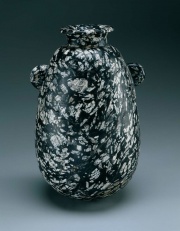Difference between revisions of "Porphyry"
Jump to navigation
Jump to search
m (Text replace - "== Authority ==" to "== Sources Checked for Data in Record ==") |
|||
| (One intermediate revision by one other user not shown) | |||
| Line 1: | Line 1: | ||
| − | [[File:21.2787-CR9461-d1.jpg|thumb|]] | + | [[File:21.2787-CR9461-d1.jpg|thumb|Porphyry<br>MFA# 21.2787]] |
== Description == | == Description == | ||
| − | In ancient Egypt, porphyry was the name for a dark purplish-red igneous stone that was very hard and had many small, but visible crystals embedded in a fine-grain matrix. Porphory was quarried from the eastern Egyptian desert near Mons Porphyrite. Currently, the term 'porphyry' describes any [ | + | In ancient Egypt, porphyry was the name for a dark purplish-red igneous stone that was very hard and had many small, but visible crystals embedded in a fine-grain matrix. Porphory was quarried from the eastern Egyptian desert near Mons Porphyrite. Currently, the term 'porphyry' describes any [[igneous|igneous]] stone with this texture. Colorful porphyritic stones have been used for buildings, sculptures, and small ornaments. They are red, purple, and green colors and can be polished to a high gloss. Porphyritic stones have been traditionally used to make mullers and slabs for grinding pigments. |
== Synonyms and Related Terms == | == Synonyms and Related Terms == | ||
| Line 8: | Line 8: | ||
pórfido (Esp.); porphyre (Fr.); pórfiro (Port.); Porphyr (Deut.); porfier (Ned.) | pórfido (Esp.); porphyre (Fr.); pórfiro (Port.); Porphyr (Deut.); porfier (Ned.) | ||
| − | + | == Risks == | |
| − | |||
| − | |||
| − | |||
| − | |||
| − | + | * Contains silica. | |
| + | * Chronic inhalation of dust may cause silicosis. | ||
| − | + | ==Physical and Chemical Properties== | |
| + | * Density = 2.6-2.9 | ||
| − | == | + | ==Resources and Citations== |
| − | B.Aston, J.Harrell, I.Shaw, "Stone" in ''Ancient Egyptian Materials and Technology'', P.Nicholson, I.Shaw (eds.), Cambridge University Press, 2000, p. 48-50. | + | * B.Aston, J.Harrell, I.Shaw, "Stone" in ''Ancient Egyptian Materials and Technology'', P.Nicholson, I.Shaw (eds.), Cambridge University Press, 2000, p. 48-50. |
| − | |||
| − | |||
* Ralph Mayer, ''A Dictionary of Art Terms and Techniques'', Harper and Row Publishers, New York, 1969 (also 1945 printing) | * Ralph Mayer, ''A Dictionary of Art Terms and Techniques'', Harper and Row Publishers, New York, 1969 (also 1945 printing) | ||
Latest revision as of 13:53, 17 August 2022
Description
In ancient Egypt, porphyry was the name for a dark purplish-red igneous stone that was very hard and had many small, but visible crystals embedded in a fine-grain matrix. Porphory was quarried from the eastern Egyptian desert near Mons Porphyrite. Currently, the term 'porphyry' describes any Igneous stone with this texture. Colorful porphyritic stones have been used for buildings, sculptures, and small ornaments. They are red, purple, and green colors and can be polished to a high gloss. Porphyritic stones have been traditionally used to make mullers and slabs for grinding pigments.
Synonyms and Related Terms
pórfido (Esp.); porphyre (Fr.); pórfiro (Port.); Porphyr (Deut.); porfier (Ned.)
Risks
- Contains silica.
- Chronic inhalation of dust may cause silicosis.
Physical and Chemical Properties
- Density = 2.6-2.9
Resources and Citations
- B.Aston, J.Harrell, I.Shaw, "Stone" in Ancient Egyptian Materials and Technology, P.Nicholson, I.Shaw (eds.), Cambridge University Press, 2000, p. 48-50.
- Ralph Mayer, A Dictionary of Art Terms and Techniques, Harper and Row Publishers, New York, 1969 (also 1945 printing)
- Michael McCann, Artist Beware, Watson-Guptill Publications, New York City, 1979
- Jack Odgen, Jewellery of the Ancient World, Rizzoli International Publications Inc., New York City, 1982
- Anne Grimmer, Glossary of Building Stone Terms, A Glossary of Historic Masonry Deterioration Problems and Preservation Treatments, National Park Service, Washington DC, 1984
- Van Nostrand's Scientific Encyclopedia, Douglas M. Considine (ed.), Van Nostrand Reinhold, New York, 1976
- Random House, Webster's Encyclopedic Unabridged Dictionary of the English Language, Grammercy Book, New York, 1997
- Frank A. Lent, Trade names and Descriptions of Marbles, Limestones, Sandstones, Granites and Other Building Stones Quarried in the United States Canada and other Countries., Stone Publishing Co, New York, 1925
- Janet Burnett Grossman, Looking at Greek and Roman Sculpture in Stone, J. Paul Getty Trust, Los Angeles, 2003
- CRC Handbook of Chemistry and Physics, Robert Weast (ed.), CRC Press, Boca Raton, Florida, v. 61, 1980 Comment: density=2.6-2.9
